 Technology peripherals
Technology peripherals
 AI
AI
 Published in the Nature sub-journal, the University of Waterloo team comments on the present and future of 'quantum computers + large language models'
Published in the Nature sub-journal, the University of Waterloo team comments on the present and future of 'quantum computers + large language models'
Published in the Nature sub-journal, the University of Waterloo team comments on the present and future of 'quantum computers + large language models'
One of the key challenges in simulating today's quantum computing devices is the ability to learn and encode the complex correlations between qubits. Emerging technologies based on machine learning language models have demonstrated the unique ability to learn quantum states.
Recently, researchers from the University of Waterloo published a perspective article titled "Language models for quantum simulation" in "Nature Computational Science", emphasizing the role of language models in building quantum computers. important contributions in this regard and explore their potential role in future competition for quantum superiority. This article highlights the unique value of language models in the field of quantum computing, noting that they can be used to address the complexity and accuracy of quantum systems. Researchers believe that by using language models, the performance of quantum algorithms can be better understood and optimized, and new ideas can be provided for the development of quantum computers. The article also emphasizes the potential role of language models in the competition for quantum advantage, arguing that they can help accelerate the development of quantum computers and are expected to achieve results in solving practical problems
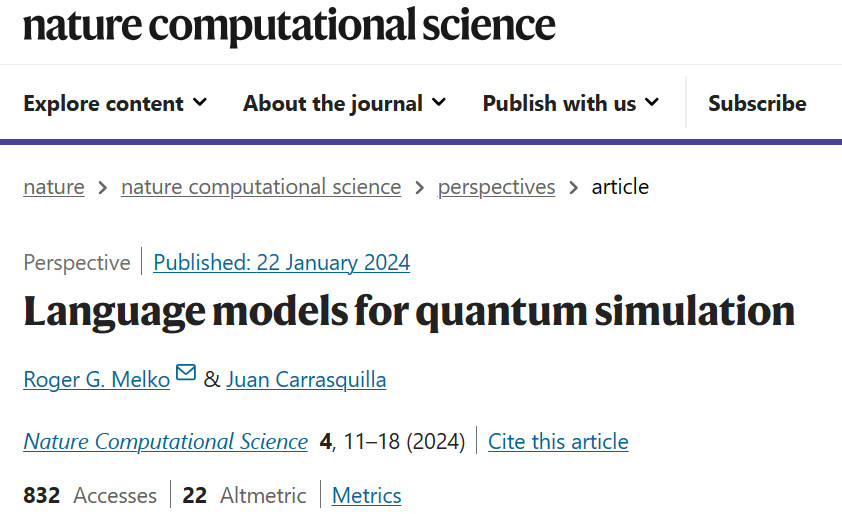
Paper link: https://www.nature.com/articles/s43588-023-00578-0
Quantum computers have begun to mature, and many devices have recently claimed to have Quantum advantage. The continued development of classical computing capabilities, such as the rapid rise of machine learning techniques, has given rise to many exciting scenarios surrounding the interplay between quantum and classical strategies. As machine learning continues to be rapidly integrated into the quantum computing stack, it begs the question: could it transform quantum technology in powerful ways in the future?
One of the main challenges facing current quantum computers is learning quantum states. Recently emerged generative models offer two common strategies to solve the problem of learning quantum states.
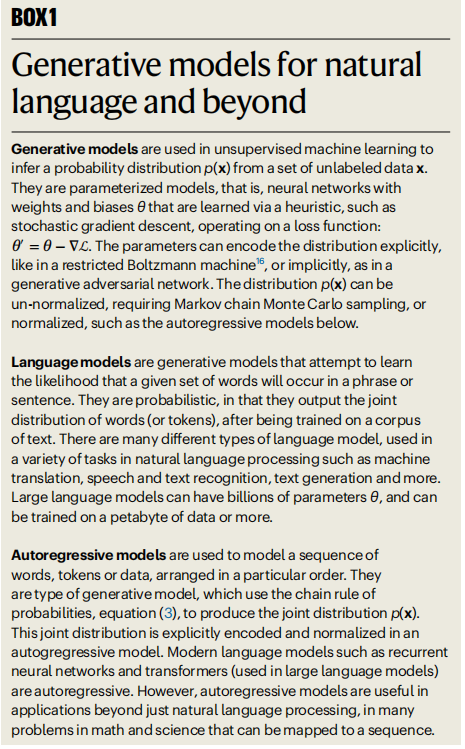
Illustration: Generative models for natural language and other fields. (Source: paper)
First, traditional maximum likelihood methods can be employed by performing data-driven learning using data sets that represent the output of a quantum computer. Second, we can use a physics approach to quantum states that exploits knowledge of interactions between qubits to define surrogate loss functions.
In either case, an increase in the number of qubits N will cause the size of the quantum state space (Hilbert space) to grow exponentially, which is called the curse of dimensionality. Therefore, there are huge challenges in the number of parameters required to represent quantum states in extended models and in the computational efficiency of finding optimal parameter values. To overcome this problem, artificial neural network generation models are a very suitable solution.
Language models are a particularly promising generative model that have become a powerful architecture for solving high-complexity language problems. Due to its scalability, it is also suitable for problems in quantum computing. Now, as industrial language models move into the trillions of parameter range, it is natural to wonder what similar large-scale models can achieve in physics, whether in applications such as extended quantum computing, or in quantum matter, materials and basic theoretical understanding of equipment.
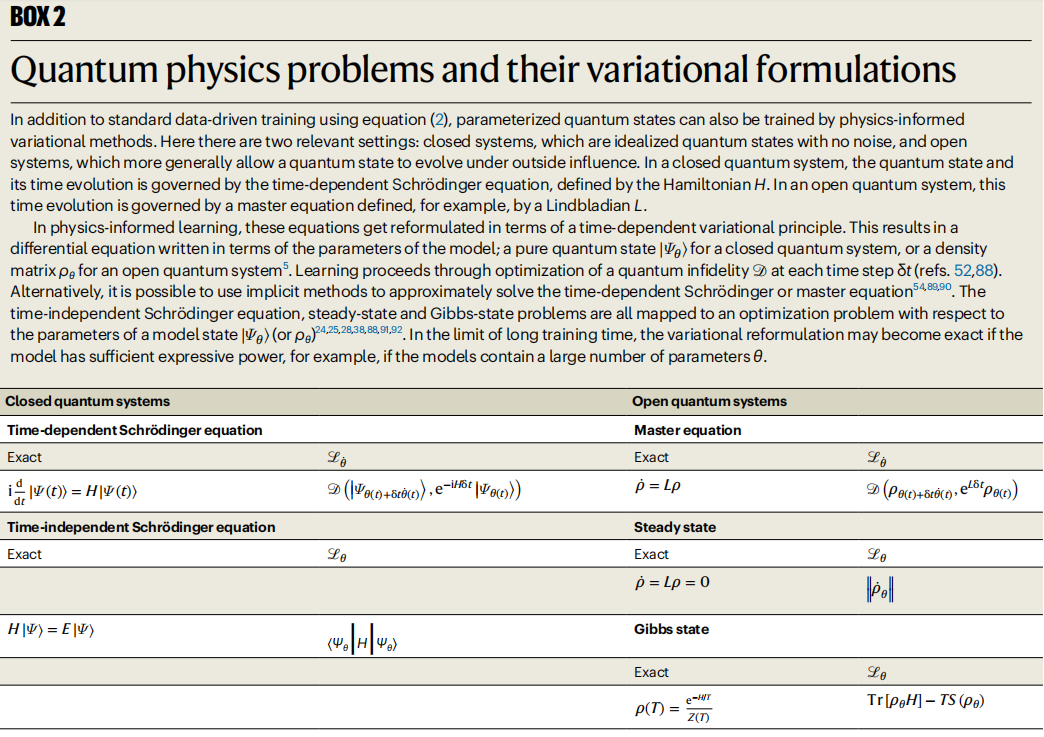
Illustration: Quantum physics problems and their variational formulas. (Source: Paper)
Autoregressive Models for Quantum Computing
Language models are generative models designed to infer probability distributions from natural language data.
The task of a generative model is to learn probabilistic relationships between words appearing in the corpus, allowing the generation of new phrases one token at a time. The main difficulty lies in modeling all the complex dependencies between words.
Similar challenges apply to quantum computers, where non-local correlations such as entanglement can lead to highly non-trivial dependencies between qubits. Therefore, an interesting question is whether the powerful autoregressive architectures developed in industry can also be applied to solve problems in strongly correlated quantum systems.

Illustration: Autoregressive strategies for text and qubit sequences. (Source: Paper)
RNN Wave Function
RNN is any neural network that contains recurrent connections such that the output of an RNN unit depends on the previous output. Since 2018, the use of RNNs has rapidly expanded to cover a variety of the most challenging tasks in understanding quantum systems.
A key advantage of RNNs suitable for these tasks is their ability to learn and encode highly significant correlations between qubits, including quantum entanglement that is non-local in nature.
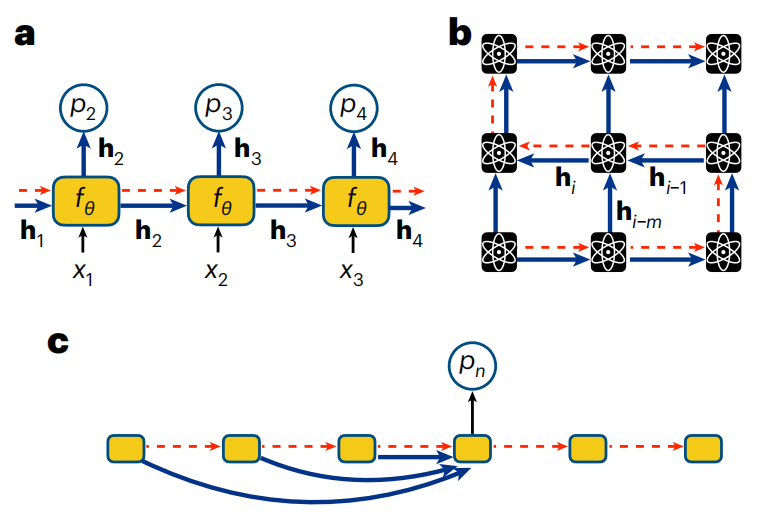
#Illustration: RNN for qubit sequences. (Source: paper)
Physicists have used RNNs for a variety of innovative uses related to quantum computing. RNNs have been used for the task of reconstructing quantum states from qubit measurements. RNNs can also be used to simulate the dynamics of quantum systems, which is considered one of the most promising applications of quantum computing and therefore a key task in defining quantum advantage. RNNs have been used as a strategy to build neural error-correcting decoders, a key element in the development of fault-tolerant quantum computers. Additionally, RNNs are able to leverage data-driven and physics-inspired optimizations, enabling an increasing number of innovative uses in quantum simulations.
The physicist community continues to actively develop RNNs, hoping to use them to accomplish the increasingly complex computational tasks encountered in the era of quantum advantage. The computational competitiveness of RNNs with tensor networks in many quantum tasks, coupled with their natural ability to harness the value of qubit measurement data, suggests that RNNs will continue to play an important role in simulating complex tasks on quantum computers in the future.
Transformer Quantum State
#While RNNs have achieved great success in natural language tasks over the years, they have recently lost ground in industry due to Transformer Overshadowed by self-attention mechanisms, the Transformer is a key component of today's large language model (LLM) encoder-decoder architecture.
The success of scaling Transformers, and the important questions raised by the non-trivial emergence phenomena they exhibit in language tasks, have long fascinated physicists, for whom, Achieving scaling is a major goal of quantum computing research.
Essentially, Transformer is a simple autoregressive model. However, unlike RNNs, which implicitly encode correlations through hidden vectors, the conditional distribution output by a Transformer model explicitly depends on all other variables in the sequence regarding autoregressive properties. This is accomplished through the self-attention mechanism of causal shielding.
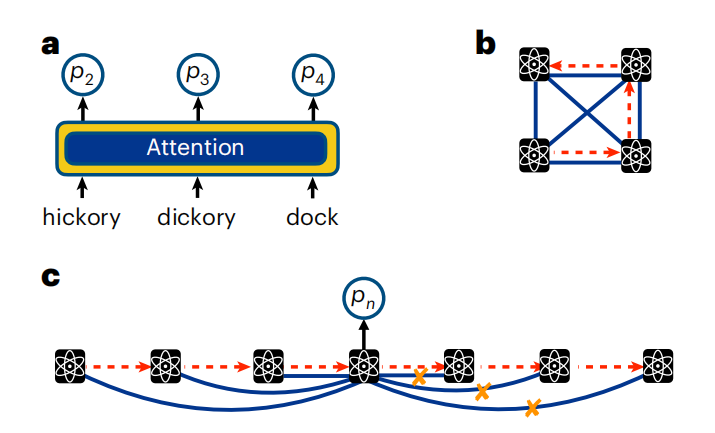
Illustration: Note the text and qubit sequence. (Source: paper)
As with language data, attention in quantum systems is computed by taking qubit measurements and transforming them through a series of parameterized functions. By training a bunch of these parameterized functions, the Transformer can learn the dependencies between qubits. With the attention mechanism, there is no need to relate the geometry of the conveyed hidden states (as in RNNs) to the physical arrangement of the qubits.
By leveraging this architecture, Transformers with billions or trillions of parameters can be trained.
Hybrid two-step optimization that combines data-driven and physics-inspired learning is important for the current generation of quantum computers, and Transformer has been demonstrated to mitigate the problems that arise in today’s imperfect output data. errors and may form the basis for a robust error correction protocol to support the development of truly fault-tolerant hardware in the future.
As the scope of research involving Transformers in quantum physics continues to rapidly expand, a series of interesting questions remain.
The Future of Language Models for Quantum Computing
Although physicists have only been exploring them for a short time, language models are showing promise in their application to quantum computing. It has achieved remarkable success against a wide range of challenges in the field. These results indicate many promising future research directions.
Another key use case for language models in quantum physics comes from their ability to optimize, not through data, but through knowledge of the Hamiltonian or Lindbladian fundamental qubit interactions .
Наконец, языковая модель открывает новую область гибридного обучения за счет сочетания оптимизации на основе данных и оптимизации на основе вариаций. Эти новые стратегии предлагают новые способы уменьшения ошибок и демонстрируют значительные улучшения в вариационном моделировании. Поскольку генеративные модели недавно были адаптированы в квантовые декодеры с исправлением ошибок, гибридное обучение может стать важным шагом на пути к будущему Святому Граалю отказоустойчивых квантовых компьютеров. Это говорит о том, что между квантовыми компьютерами и языковыми моделями, обученными на их выходе, вот-вот возникнет благоприятный цикл.
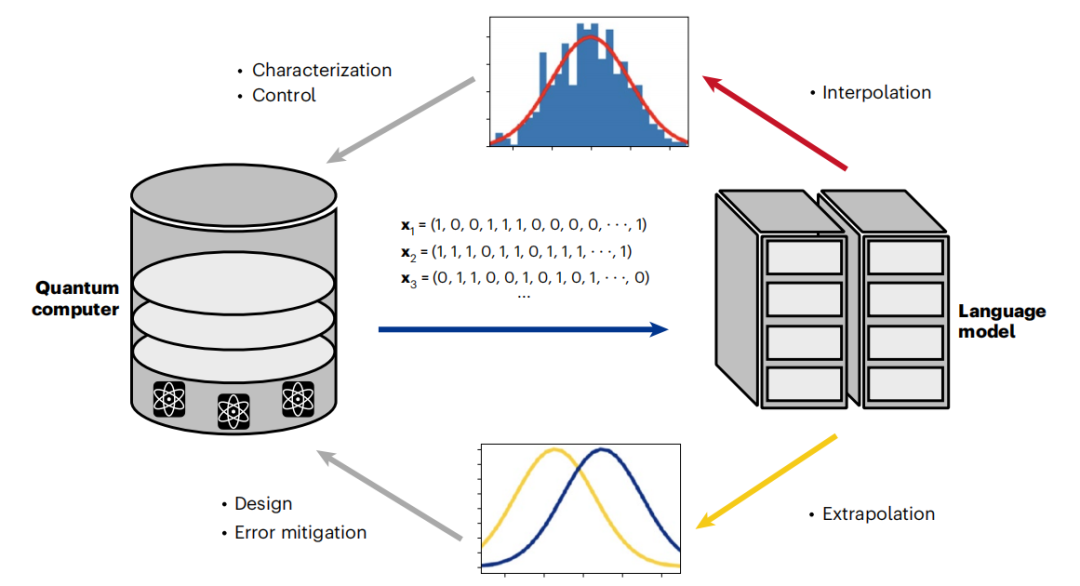
Иллюстрация: Языковая модель реализует расширение квантовых вычислений посредством эффективного цикла. (Источник: Paper)
Заглядывая в будущее, самые захватывающие возможности связать область языковых моделей с квантовыми вычислениями заключаются в их способности демонстрировать масштаб и появление.
Сегодня, с демонстрацией новых свойств LLM, был пройден новый рубеж, поднимающий множество интересных вопросов. Учитывая достаточное количество обучающих данных, сможет ли LLM изучить цифровую копию квантового компьютера? Как включение языковых моделей в стек управления повлияет на характеристики и конструкцию квантовых компьютеров? Если масштаб достаточно велик, сможет ли LLM показать появление макроскопических квантовых явлений, таких как сверхпроводимость?
Пока теоретики размышляют над этими вопросами, физики-экспериментаторы и вычислительные физики начали всерьез применять языковые модели для проектирования, описания и управления современными квантовыми компьютерами. Переступая порог квантового преимущества, мы также вступаем на новую территорию в расширении языковых моделей. Хотя трудно предсказать, как будет развиваться столкновение квантовых компьютеров и LLM, ясно то, что фундаментальные сдвиги, вызванные взаимодействием этих технологий, уже начались.
The above is the detailed content of Published in the Nature sub-journal, the University of Waterloo team comments on the present and future of 'quantum computers + large language models'. For more information, please follow other related articles on the PHP Chinese website!

Hot AI Tools

Undresser.AI Undress
AI-powered app for creating realistic nude photos

AI Clothes Remover
Online AI tool for removing clothes from photos.

Undress AI Tool
Undress images for free

Clothoff.io
AI clothes remover

AI Hentai Generator
Generate AI Hentai for free.

Hot Article

Hot Tools

Notepad++7.3.1
Easy-to-use and free code editor

SublimeText3 Chinese version
Chinese version, very easy to use

Zend Studio 13.0.1
Powerful PHP integrated development environment

Dreamweaver CS6
Visual web development tools

SublimeText3 Mac version
God-level code editing software (SublimeText3)

Hot Topics
 1379
1379
 52
52
 Debian mail server firewall configuration tips
Apr 13, 2025 am 11:42 AM
Debian mail server firewall configuration tips
Apr 13, 2025 am 11:42 AM
Configuring a Debian mail server's firewall is an important step in ensuring server security. The following are several commonly used firewall configuration methods, including the use of iptables and firewalld. Use iptables to configure firewall to install iptables (if not already installed): sudoapt-getupdatesudoapt-getinstalliptablesView current iptables rules: sudoiptables-L configuration
 How debian readdir integrates with other tools
Apr 13, 2025 am 09:42 AM
How debian readdir integrates with other tools
Apr 13, 2025 am 09:42 AM
The readdir function in the Debian system is a system call used to read directory contents and is often used in C programming. This article will explain how to integrate readdir with other tools to enhance its functionality. Method 1: Combining C language program and pipeline First, write a C program to call the readdir function and output the result: #include#include#include#includeintmain(intargc,char*argv[]){DIR*dir;structdirent*entry;if(argc!=2){
 Debian mail server SSL certificate installation method
Apr 13, 2025 am 11:39 AM
Debian mail server SSL certificate installation method
Apr 13, 2025 am 11:39 AM
The steps to install an SSL certificate on the Debian mail server are as follows: 1. Install the OpenSSL toolkit First, make sure that the OpenSSL toolkit is already installed on your system. If not installed, you can use the following command to install: sudoapt-getupdatesudoapt-getinstallopenssl2. Generate private key and certificate request Next, use OpenSSL to generate a 2048-bit RSA private key and a certificate request (CSR): openss
 How to perform digital signature verification with Debian OpenSSL
Apr 13, 2025 am 11:09 AM
How to perform digital signature verification with Debian OpenSSL
Apr 13, 2025 am 11:09 AM
Using OpenSSL for digital signature verification on Debian systems, you can follow these steps: Preparation to install OpenSSL: Make sure your Debian system has OpenSSL installed. If not installed, you can use the following command to install it: sudoaptupdatesudoaptininstallopenssl to obtain the public key: digital signature verification requires the signer's public key. Typically, the public key will be provided in the form of a file, such as public_key.pe
 How Debian OpenSSL prevents man-in-the-middle attacks
Apr 13, 2025 am 10:30 AM
How Debian OpenSSL prevents man-in-the-middle attacks
Apr 13, 2025 am 10:30 AM
In Debian systems, OpenSSL is an important library for encryption, decryption and certificate management. To prevent a man-in-the-middle attack (MITM), the following measures can be taken: Use HTTPS: Ensure that all network requests use the HTTPS protocol instead of HTTP. HTTPS uses TLS (Transport Layer Security Protocol) to encrypt communication data to ensure that the data is not stolen or tampered during transmission. Verify server certificate: Manually verify the server certificate on the client to ensure it is trustworthy. The server can be manually verified through the delegate method of URLSession
 How to do Debian Hadoop log management
Apr 13, 2025 am 10:45 AM
How to do Debian Hadoop log management
Apr 13, 2025 am 10:45 AM
Managing Hadoop logs on Debian, you can follow the following steps and best practices: Log Aggregation Enable log aggregation: Set yarn.log-aggregation-enable to true in the yarn-site.xml file to enable log aggregation. Configure log retention policy: Set yarn.log-aggregation.retain-seconds to define the retention time of the log, such as 172800 seconds (2 days). Specify log storage path: via yarn.n
 Centos shutdown command line
Apr 14, 2025 pm 09:12 PM
Centos shutdown command line
Apr 14, 2025 pm 09:12 PM
The CentOS shutdown command is shutdown, and the syntax is shutdown [Options] Time [Information]. Options include: -h Stop the system immediately; -P Turn off the power after shutdown; -r restart; -t Waiting time. Times can be specified as immediate (now), minutes ( minutes), or a specific time (hh:mm). Added information can be displayed in system messages.
 How to configure HTTPS server in Debian OpenSSL
Apr 13, 2025 am 11:03 AM
How to configure HTTPS server in Debian OpenSSL
Apr 13, 2025 am 11:03 AM
Configuring an HTTPS server on a Debian system involves several steps, including installing the necessary software, generating an SSL certificate, and configuring a web server (such as Apache or Nginx) to use an SSL certificate. Here is a basic guide, assuming you are using an ApacheWeb server. 1. Install the necessary software First, make sure your system is up to date and install Apache and OpenSSL: sudoaptupdatesudoaptupgradesudoaptinsta



